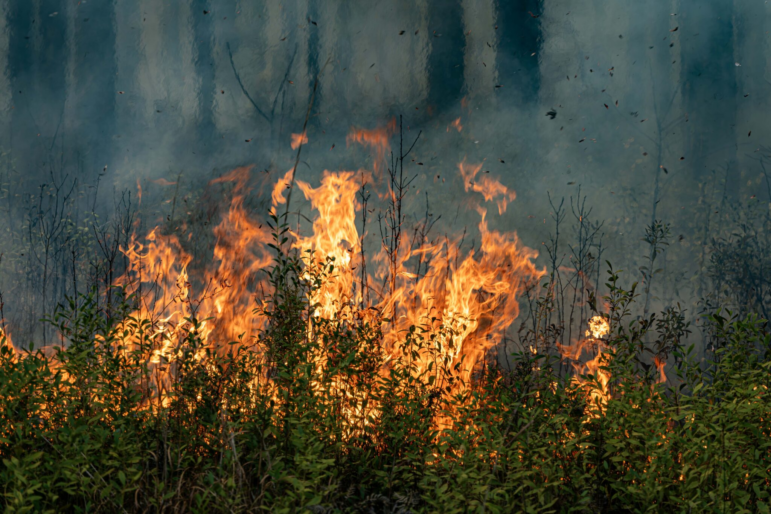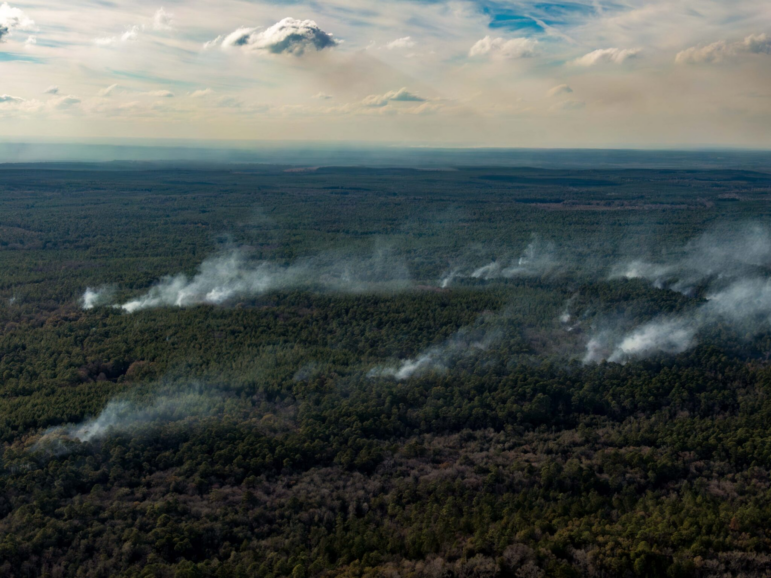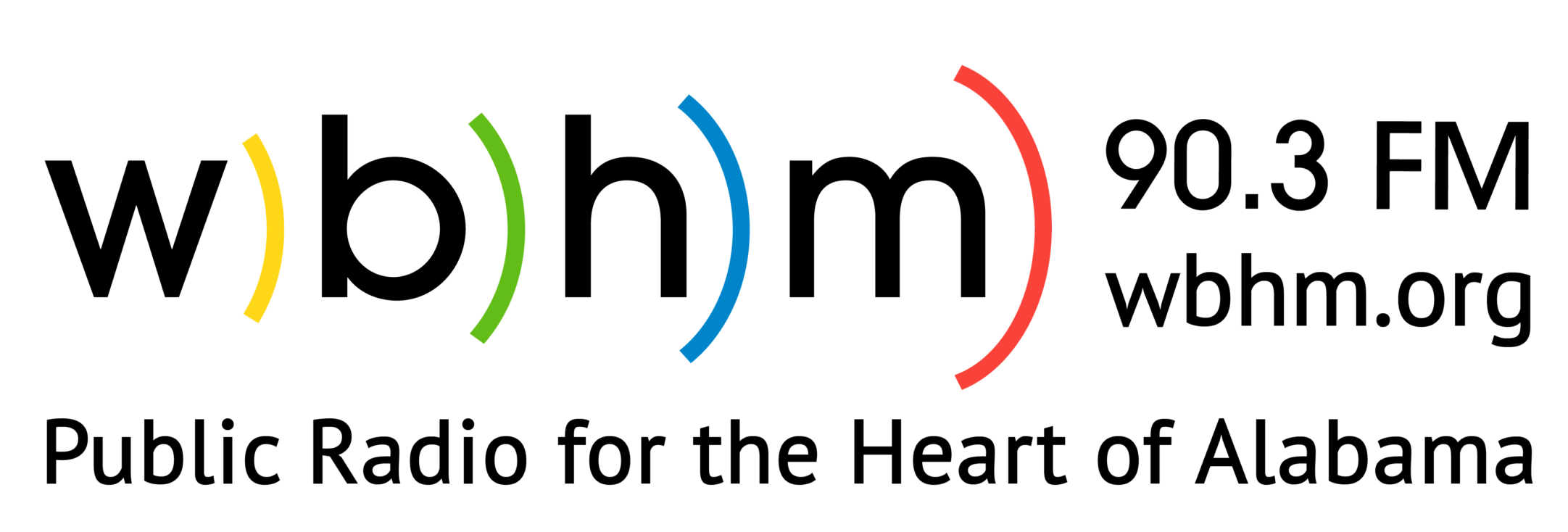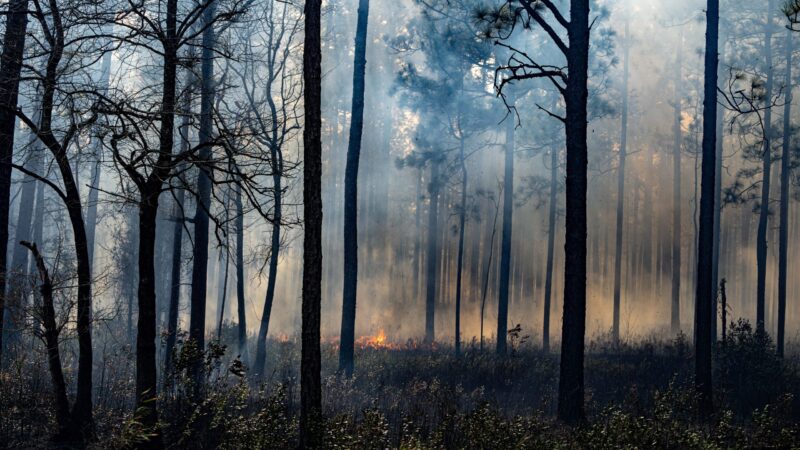What’s Causing Birmingham’s Code Red Air Quality Alert?
Prescribed burns are commonly used to limit fuel availability and reduce the number of wildfires. Research suggests the blazes also cause excess premature deaths due to particulate pollution.
This article originally appeared on Inside Climate News, a nonprofit, independent news organization that covers climate, energy and the environment. It is republished with permission. Sign up for their newsletter here.
By Lee Hedgepeth, Inside Climate News
BIRMINGHAM, Ala.—On Monday, as afternoon sank into evening, a haze fell over the Magic City.
Soon, the questions began popping up.
“What’s burning?” Julia Juarez, one Birmingham resident, posted on social media.
“I don’t know,” another resident replied. “I kept trying to clean my glasses.”
His glasses weren’t the problem.
The real cause of the smoke—a prescribed burn about 70 miles northwest of Birmingham in Bankhead National Forest—left public officials scrambling to warn residents of the resulting health risks.
Now, experts have urged nearly 900,000 residents in two of Alabama’s most populous counties to limit outdoor activity because of the poor air quality caused by the planned burn.
On Monday, the National Oceanic and Atmospheric Administration and the National Weather Service issued a Code Red Air Quality Alert for Shelby County and Jefferson County, which includes Birmingham and its suburbs. The alert began just before 8 p.m. Monday evening and lasts until 11 p.m. Tuesday night.
“Under Code Red conditions, particulate matter concentrations are expected to reach unhealthy levels,” the alert said. “People with heart or lung disease, older adults, and children should avoid all physical activity outdoors. Everyone else should avoid prolonged or heavy exertion.”
An air quality forecast released by the Jefferson County Department of Health attributed the poor air quality to the prescribed burn. Smoke from the blaze in Bankhead National Forest near the Winston/Lawrence County line moved into the metro region overnight and has been trapped under an “inversion,” which occurs when warmer air high in the atmosphere traps relatively cooler air—and in this case the smoke accompanying it—below.
The inversion and resulting trapped plume were clearly visible miles away on Monday evening. The smoke’s journey from Bankhead National Forest into the Birmingham metro was also visible in satellite imagery taken Monday evening.
Code Red Air Quality alerts are issued when particulate matter—the amount of small pollution particles in the air—reaches unhealthy levels.
“Particulate matter contains microscopic solids or liquid droplets that are so small that they can be inhaled and cause serious health problems,” according to the Environmental Protection Agency. “Some particles less than 10 micrometers in diameter can get deep into your lungs and some may even get into your bloodstream. Of these, particles less than 2.5 micrometers in diameter, also known as fine particles or PM2.5, pose the greatest risk to health.”
Exposure to PM2.5 can affect both your lungs and your heart, the federal agency has said. Studies have linked particle pollution exposure to a variety of problems, including premature death in people with heart or lung disease, nonfatal heart attacks, irregular heartbeat, aggravated asthma, decreased lung function and increased respiratory symptoms, such as irritation of the airways, coughing or difficulty breathing.

The local health department’s air quality warning specifically cited PM2.5 concentrations as the reasons for the Code Red alert.
“PM2.5 concentrations have already dramatically increased and will continue to do so overnight and will not decrease until the inversion breaks mid-morning,” JCDH’s air quality forecast said as of Monday night.
Scientists have concluded that climate change is compounding the impacts of particulate matter pollution on human health.
“In the Southeast, climate change threatens [air quality] improvements by creating favorable conditions for increases in smog and wildland fire emissions,” the National Climate Assessment concluded.
The report specifically highlighted potential risks posed even by planned, controlled burns.
“While the impacts of wildfires on air quality are widely recognized, less is known about the impacts of prescribed burns versus wildfires on air quality,” the report said. “Prescribed burns reduce the risk of wildfire damage to the environment, homes, and infrastructure, although areas with intensive prescribed burning tend to be near communities with higher social vulnerability scores, which subsequently experience more negative health outcomes from the smoke.”
In its announcement about the current air quality alert, the Jefferson County Department of Health recommended rescheduling outdoor activities for days when particle levels are lower. If you do find yourself outdoors, however, health officials urge you to avoid exposure to visible smoke, to limit driving and engine idling and to avoid using gasoline-powered lawn and garden equipment.
If you exercise outdoors during the alert, health experts say, walk instead of jog and avoid doing so near busy roads.
Outside particulate matter can also affect indoor air quality, according to experts.
“Keep windows and doors closed to prevent further circulation of particles,” according to JCDH. “You can further reduce indoor particle levels by eliminating tobacco smoke, limiting cooking with wood, coal, oil, or natural gas, and limiting the use of candles, incense, and household cleaners.”
If breathing becomes difficult, health officials say to immediately move indoors.
Prescribed burns have long been used to manage wildfire risks by limiting the availability of fuel—dry vegetation—in areas prone to burning.

Of late, Alabama has faced significant difficulty in arresting the impacts of wildfires.
On March 5, officials with the Alabama Forestry Commission, the government agency charged with wildfire control, said that its firefighters combatted 181 wildfires—a record number for one day. Those fires resulted in the burning of approximately 1,700 acres across the state.
Federal officials announced in January that they planned to conduct prescribed burns across nearly 200,000 acres of land in Alabama national forests in the first six months of the year, including more than 21,000 acres in Bankhead National Forest.
Officials said at the time that great care is taken to limit the potential for harm caused by planned burns but that the benefits outweigh the risks.
“As a result [of these prescribed burns], hazardous fuels are reduced and human communities are protected from extreme fires,” said Martel Knipe, a fire management officer with the U.S. Forest Service. “Using prescribed fires reduces pest problems and disease spread. It also restores nutrients to the soil so that trees and flowers can grow.”
On Monday, the Forest Service announced it would start a burn of approximately 780 acres about six miles east of Pebble, Alabama, near Wolfpen Hunter Camp inside Bankhead National Forest.
“During today’s prescribed burn, County Road 60 forms the burn boundary and should be traveled with caution,” the announcement said. “The public may notice Forest Service fire crews and equipment. Smoke may also be visible on state highways 33, 195 southeast of the burn area. The wind is expected to be out of the northwest and will carry the smoke to the southeast. As the temperatures cool later today, the smoke may begin to settle in the Rock Creek and Houston communities.”
By Monday evening, however, smoke from the blaze had settled well beyond Rock Creek and Houston. By midnight, PM2.5 concentrations in Birmingham were 4.3 times the World Health Organization’s annual PM2.5 guideline value, according to federal air quality measurements.
Recent research has attempted to more clearly quantify the impacts of prescribed burns on health impacts in the southeastern U.S. In a November 2024 study published in the journal Environment International, a team of researchers reviewed data on prescribed burns in the southeast from 2013 to 2020 and concluded that exposure to particulate matter caused by the planned fires resulted in more than 20,000 “excess non-accidental premature deaths” across 10 states.
During that eight-year period, prescribed burns, which make up around 79 percent of the total number of wildland fires in Alabama, resulted in an average of 270 excess premature deaths in the state each year—around 2,100 deaths over the studied period, according to the researchers.
While some research has indeed demonstrated benefits of prescribed burns under certain conditions, the authors suggested, more research is needed to properly weigh the benefits and risks associated with the planned blazes.
The Forest Service’s prescribed burn map indicates the agency plans to burn additional land within Bankhead National Forest in the coming weeks and months.
At least 43 dead in catastrophic Texas flooding and dozens missing from girls camp
Flash flooding slammed the Texas Hill Country overnight on Friday. At least 27 girls from a summer camp next to the Guadalupe River remain missing.
How this long-lost Chinese typewriter from the 1940s changed modern computing
The concepts in the MingKwai typewriter underlie how Chinese, Japanese and Korean are typed today. The typewriter, patented in 1946, was found last year in an upstate New York basement.
North Korea has a new luxury beach resort. But the country isn’t open to most tourists
North Korean leader Kim Jong Un said he wants the luxury resort on the eastern seacoast to become a "world destination," but the country has been reluctant to allow in foreign tourists.
Mariska Hargitay walks a fine line in ‘My Mom Jayne’
It's natural to feel some skepticism when a celebrity makes a documentary about their own family. But Law & Order star Mariska Hargitay' tells a story that is both effective and empathetic.
Ukraine says it struck a Russian airbase as Russia sent drones into Ukraine
Ukraine said it struck a Russian airbase on Saturday, while Russia continued to pound Ukraine with hundreds of drones overnight, dashing hopes for a breakthrough in efforts to end the war.
Will Trump’s megabill help Democrats win the House?
Democrats feel that Trump's tax and spending bill gives them an opening ahead of the 2026 midterms. But if they want to win back the House, they're going to have to get their own house in order first.









